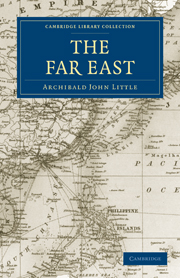Book contents
- Frontmatter
- PREFACE
- EDITORIAL NOTE
- Contents
- LIST OF MAPS AND ILLUSTRATIONS
- CHAPTER I DEFINITION
- CHAPTER II THE CENTRAL KINGDOM: CHINA
- CHAPTER III THE NORTHERN BASIN. THE YELLOW RIVER
- CHAPTER IV THE MIDDLE BASIN: PART I. THE YANGTSE RIVER
- CHAPTER V THE MIDDLE BASIN: PART II. THE PROVINCE OF SZECHUAN
- CHAPTER VI THE MIDDLE BASIN: PART III. THE CHENGTU PLATEAU
- CHAPTER VII THE MIDDLE BASIN: PART IV. THE LOWER YANGTSE PROVINCES
- CHAPTER VIII THE INTERMEDIATE PROVINCES
- CHAPTER IX THE SOUTHERN BASIN. YUNNAN TO CANTON
- CHAPTER X THE DEPENDENCIES: PART I. MANCHURIA
- CHAPTER XI THE DEPENDENCIES: PART II. MONGOLIA
- CHAPTER XII THE DEPENDENCIES: PART III. TURKESTAN
- CHAPTER XIII THE DEPENDENCIES: PART IV. TIBET
- CHAPTER XIV WHILOM DEPENDENCIES: PART I. INDO-CHINA
- CHAPTER XV WHILOM DEPENDENCIES: PART II. COREA
- CHAPTER XVI THE BUFFER KINGDOM: SIAM
- CHAPTER XVII THE ISLAND EMPIRE: JAPAN
- INDEX
- Plate section
CHAPTER V - THE MIDDLE BASIN: PART II. THE PROVINCE OF SZECHUAN
Published online by Cambridge University Press: 05 October 2010
- Frontmatter
- PREFACE
- EDITORIAL NOTE
- Contents
- LIST OF MAPS AND ILLUSTRATIONS
- CHAPTER I DEFINITION
- CHAPTER II THE CENTRAL KINGDOM: CHINA
- CHAPTER III THE NORTHERN BASIN. THE YELLOW RIVER
- CHAPTER IV THE MIDDLE BASIN: PART I. THE YANGTSE RIVER
- CHAPTER V THE MIDDLE BASIN: PART II. THE PROVINCE OF SZECHUAN
- CHAPTER VI THE MIDDLE BASIN: PART III. THE CHENGTU PLATEAU
- CHAPTER VII THE MIDDLE BASIN: PART IV. THE LOWER YANGTSE PROVINCES
- CHAPTER VIII THE INTERMEDIATE PROVINCES
- CHAPTER IX THE SOUTHERN BASIN. YUNNAN TO CANTON
- CHAPTER X THE DEPENDENCIES: PART I. MANCHURIA
- CHAPTER XI THE DEPENDENCIES: PART II. MONGOLIA
- CHAPTER XII THE DEPENDENCIES: PART III. TURKESTAN
- CHAPTER XIII THE DEPENDENCIES: PART IV. TIBET
- CHAPTER XIV WHILOM DEPENDENCIES: PART I. INDO-CHINA
- CHAPTER XV WHILOM DEPENDENCIES: PART II. COREA
- CHAPTER XVI THE BUFFER KINGDOM: SIAM
- CHAPTER XVII THE ISLAND EMPIRE: JAPAN
- INDEX
- Plate section
Summary
Starting from the west and following down the course of the Yangtse river, the first province of the middle basin is Szechuan. The name means ‘Four Streams,’ derived probably from the fact that the four great north and south valleys which comprise its richest agricultural region, and that earliest settled by the Chinese, are watered by four parallel rivers which take their rise in the mountains to the north and debouch into the Yangtse, which flows along the southern frontier of the province: these rivers, which form such a conspicuous feature in its geography, are the Min, the Chung-kiang (or Central River), the Fu-kiang and the Kialing,—the two latter uniting into one stream a few miles above their junction with the Yangtse at the Treaty Port Chungking. Farther to the west are three larger rivers, likewise running in parallel channels north and south—the Kinsha, the Yalung and the Tatu-ho, but these, though larger in volume, are comparatively of small importance, as they flow through the wild mountains of the Tibetan border as unnavigable torrents.
The last of these rivers once formed the western boundary of the province, but recently the boundary has been moved farther west until it now includes the right bank of the Kinsha, west of Batang in Tibet: thus the area of Szechuan is now put down as 185,000 square miles and the population at fifty to sixty millions; the valuable and populous half lies east of the Min river, the western half being thinly peopled by aboriginal tribes, and valuable only for its wealth in minerals ; isolated fertile valleys are found amongst the lofty mountain mass which fills this region, such as the Chien-chang valley with its chief city, Ningyuen, in the south, and the rich valley of Yachow in the north.
- Type
- Chapter
- Information
- The Far East , pp. 69 - 77Publisher: Cambridge University PressPrint publication year: 2010First published in: 1905



